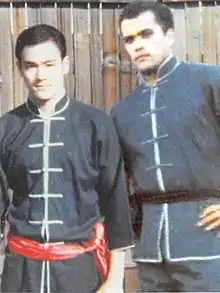James DeMile
James W. DeMile (Born 1935) is an American martial artist and author, he was among the first group of students of Bruce Lee,[1][2] whom he met in 1959, as they both attended Edison Technical School.[3] In 1963, DeMile appeared in Lee’s only book, The Philosophical Art of Self Defense. He is an inductee in the AMAA Who’s Who in the Martial Arts Hall of Fame and Black Belt Magazine Hall of Fame.[4][5][6][7]
| James DeMile | |
|---|---|
 Bruce Lee and James DeMile | |
| Born | 1935 San Francisco |
| Style | Non-Classical Kung-Fu Boxing Jeet Kune Do |
| Teacher(s) | Bruce Lee |
| Rank | Grandmaster |
Training with Bruce Lee
DeMile is of mixed race ancestry. He reportedly experienced a difficult childhood in an orphanage, with a history of teenage gang fights and petty crimes.[8] In 1959, a year after arriving in America, Bruce Lee decided to share his martial arts knowledge. What started as informal sparring sessions between friends turned into a three-school business that cemented Bruce's pioneering approach to the art of hand-in-hand fighting.[7][3]
Lee attracted DeMile as his first student in a public display of his talents when he attended Edison Technical School in Seattle. Looking for a sparring partner in the audience, the 19-year-old Lee discovered DeMile, 24, a former Air Force heavyweight boxing champ. Bruce noticed DeMile's athletic build and called him on stage. DeMile thought it would be an easy fight because his opponent was only 5'7 "tall and weighed no more than 140 pounds, but Lee soon beat him. Impressed, DeMile turned to Lee after the sparring to ask him if he could learn from him.[8][7][3]
These public demonstrations attracted a small following, The group practiced outside Ruby Chow's restaurant where Lee waited tables after a long shift taking orders and serving customers DeMile introduced Lee to one of the three men he would later certify as an instructor, 38 year old Taky Kimura. [7][3]
In the book Disciples of the Dragon, DeMile stated that they we’re all dummies for Lee’s training. One of the reasons Lee modified his Wing Chun techniques and created Jeet Kune Do, was because the westerners were bigger and stronger than him and once they would learn the basics of Wing Chun, they could become a real threat to him.[2][3]
Martial Arts Achievements
Virgin Australia Airlines contracted Demile to create a program to train its in-flight cabin and ground crew staff with the tactics to disarm and immobilize a threatening passenger or terrorist.
Demile has trained United States Secret Service operatives, FBI agents, Federal marshalls and police officers specializing in riots.[1]
Bibliography
Filmography
| Year | Title | Role | Notes |
|---|---|---|---|
| 1967 | The Last Adventure | N/A | The Last Adventure at IMDb |
| 1993 | Bruce Lee: The Curse of the Dragon | Himself | The Curse of the Dragon at IMDb |
References
- "Next Evolution Martial Arts Training Course Developed By Bruce Lee's Leading Student". virginaustralia.com. Virgin Australia Airlines. Retrieved 8 January 2021.
- Bax, Paul (2008). Disciples of the Dragon: Reflections from the Students of Bruce Lee. Outskirts Pr. ISBN 978-1432722234.
- Paul Bax (2004). Bruce Lee's First Generation. Black Belt Magazine. p. 99.
- Glover, Jesse R. (1976). Bruce Lee Between Win Chun and Jeet Kune Do. Unspecified vendor. ISBN 0-9602328-0-X.
- Russo, Charles (2016). Striking Distance: Bruce Lee and the Dawn of Martial Arts in America. U of Nebraska Press. ISBN 978-0803290518.
- Thomas, Bruce (1994). Bruce Lee: Fighting Spirit : a Biography. Frog Books. ISBN 978-1-883319-25-0.
- "Bruce Lee's School of Hard Knocks". Newsweek (Newsweek special edition). Newsweek Digital. 15 November 2015. Retrieved 8 January 2021.
- Russo, Charles (2016). Striking Distance: Bruce Lee and the Dawn of Martial Arts in America (reprint ed.). U of Nebraska Press. p. 50. ISBN 978-0803290518.
- DeMile, James (1977). Tao of Wing Chun Do, Bruce Lee's Chi Sao. Self published. ISBN 0918642035.
- DeMile, James (1988). Tao of Wing Chun Do: Mind and Body in Harmony. Self published. ISBN 978-0918642011.
- DeMile, James (1989). Bruce Lee's 1 and 3 Inch Power Punch. Self published. ISBN 0918642027.